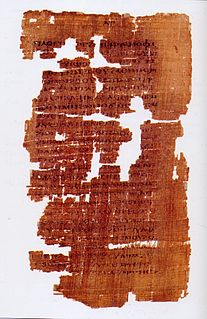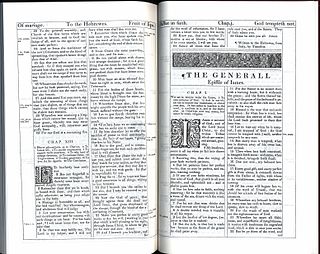Related Research Articles

The Epistle to the Ephesians, also called the Letter to the Ephesians and often shortened to Ephesians, is the tenth book of the New Testament. Its authorship has traditionally been attributed to Paul the Apostle but starting in 1792, this has been challenged as Deutero-Pauline, that is, pseudepigrapha written in Paul's name by a later author strongly influenced by Paul's thought, probably "by a loyal disciple to sum up Paul's teaching and to apply it to a new situation fifteen to twenty-five years after the Apostle's death".

The Epistle to the Philippians, commonly referred to as Philippians, is a Pauline epistle of the New Testament of the Christian Bible. The epistle is attributed to Paul the Apostle and Timothy is named with him as co-author or co-sender. The letter is addressed to the Christian church in Philippi. Paul, Timothy, Silas first visited Philippi in Greece (Macedonia) during Paul's second missionary journey from Antioch, which occurred between approximately 49 and 51 AD. In the account of his visit in the Acts of the Apostles, Paul and Silas are accused of "disturbing the city".

The Epistle of Paul to the Colossians is the twelfth book of the New Testament. It was written, according to the text, by Paul the Apostle and Timothy, and addressed to the church in Colossae, a small Phrygian city near Laodicea and approximately 100 miles (160 km) from Ephesus in Asia Minor.

The Epistle to the Laodiceans is a letter of Paul the Apostle, the original existence of which is inferred from an instruction to the congregation in Colossae to send their letter to the believing community in Laodicea, and likewise obtain a copy of the letter "from Laodicea".
And when this letter has been read to you, see that it is also read before the church at Laodicea, and that you yourselves read the letter which will be forwarded from there.

The New Testament (NT) is the second division of the Christian biblical canon. It discusses the teachings and person of Jesus, as well as events in first-century Christianity. The New Testament's background, the first division of the Christian Bible, is called the Old Testament, which is based primarily upon the Hebrew Bible; together they are regarded as sacred scripture by Christians.

The Second Epistle to the Thessalonians, commonly referred to as Second Thessalonians or 2 Thessalonians is a book from the New Testament of the Christian Bible. It is traditionally attributed to Paul the Apostle, with Timothy as a co-author. Modern biblical scholarship is divided on whether the epistle was written by Paul; some scholars believe Paul wrote this epistle, but others reject its authenticity based on what they see as differences in style and theology between this and the First Epistle to the Thessalonians.

An epistle is a writing directed or sent to a person or group of people, usually an elegant and formal didactic letter. The epistle genre of letter-writing was common in ancient Egypt as part of the scribal-school writing curriculum. The letters in the New Testament from Apostles to Christians are usually referred to as epistles. Those traditionally attributed to Paul are known as Pauline epistles and the others as catholic epistles.

Marcion of Sinope was an early Christian theologian, an evangelist, and an important figure in early Christianity. Marcion preached that the benevolent God of the Gospel who sent Jesus Christ into the world as the savior was the true Supreme Being, different from and opposed to the malevolent demiurge or creator god, identified with the Hebrew God of the Old Testament. He considered himself a follower of Paul the Apostle, whom he believed to have been the only true apostle of Jesus Christ, a doctrine called Marcionism. Marcion published the earliest extant fixed collection of New Testament books.

Marcionism was an early Christian dualistic belief system that originated from the teachings of Marcion of Sinope in Rome around the year 144. Marcion was an early Christian theologian, evangelist, and an important figure in early Christianity. He was the son of a bishop of Sinope in Pontus. About the middle of the 2nd century (140–155) he traveled to Rome, where he joined the Syrian Gnostic Cerdo.

The Muratorian fragment, also known as the Muratorian Canon or Canon Muratori, is a copy of perhaps the oldest known list of most of the books of the New Testament. The fragment, consisting of 85 lines, is a 7th-century Latin manuscript bound in a 7th- or 8th-century codex from the library of Columbanus's monastery at Bobbio Abbey; it contains features suggesting it is a translation from a Greek original written about 170 or as late as the 4th century. Both the degraded condition of the manuscript and the poor Latin in which it was written have made it difficult to translate. The beginning of the fragment is missing, and it ends abruptly. The fragment consists of all that remains of a section of a list of all the works that were accepted as canonical by the churches known to its original compiler. It was discovered in the Ambrosian Library in Milan by Father Ludovico Antonio Muratori (1672–1750), the most famous Italian historian of his generation, and published in 1740.

The Pauline epistles, also known as Epistles of Paul or Letters of Paul, are the thirteen books of the New Testament attributed to Paul the Apostle, although the authorship of some is in dispute. Among these epistles are some of the earliest extant Christian documents. They provide an insight into the beliefs and controversies of early Christianity. As part of the canon of the New Testament, they are foundational texts for both Christian theology and ethics.

The New Testament apocrypha are a number of writings by early Christians that give accounts of Jesus and his teachings, the nature of God, or the teachings of his apostles and of their lives. Some of these writings have been cited as scripture by early Christians, but since the fifth century a widespread consensus has emerged limiting the New Testament to the 27 books of the modern canon. Roman Catholic, Eastern Orthodox, and Protestant churches generally do not view these New Testament apocrypha as part of the Bible.

The pastoral epistles are a group of three books of the canonical New Testament: the First Epistle to Timothy the Second Epistle to Timothy, and the Epistle to Titus. They are presented as letters from Paul the Apostle to Timothy and to Titus. They are generally discussed as a group and are given the title pastoral because they are addressed to individuals with pastoral oversight of churches and discuss issues of Christian living, doctrine and leadership. The term "pastorals" was popularized in 1703 by D. N. Berdot and in 1726 by Paul Anton. Alternate nomenclature for the cluster of three letters has been proposed: "Corpus Pastorale," meant to highlight the intentional forgery of the letters as a three-part corpus, and "Letters to Timothy and Titus," meant to emphasize the individuality of the letters.

The Pauline epistles are the fourteen books in the New Testament traditionally attributed to Paul the Apostle.

The First Epistle of Paul to Timothy, usually referred to simply as First Timothy and often written 1 Timothy, is one of three letters in the New Testament of the Bible often grouped together as the pastoral epistles, along with Second Timothy and Titus. The letter, traditionally attributed to the Apostle Paul, consists mainly of counsels to his younger colleague and delegate Timothy regarding his ministry in Ephesus (1:3). These counsels include instructions on the organization of the Church and the responsibilities resting on certain groups of leaders therein as well as exhortations to faithfulness in maintaining the truth amid surrounding errors.
The Laodicean Church was a Christian community established in the ancient city of Laodicea. The church was established in the Apostolic Age, the earliest period of Christianity, and is probably best known for being one of the Seven churches of Asia addressed by name in the Book of Revelation.

The Epistle to the Hebrews of the Christian Bible is one of the New Testament books whose canonicity was disputed. Traditionally, Paul the Apostle was thought to be the author. However, since the third century this has been questioned, and the consensus among most modern scholars is that the author is unknown.

The authorship of the Petrine epistles is an important question in biblical criticism, parallel to that of the authorship of the Pauline epistles, since scholars have long sought to determine who were the exact authors of the New Testament letters. Most scholars today conclude that Saint Peter was not the author of the two epistles that are attributed to him and that they were written by two different authors.

A biblical canon is a set of texts which a particular Jewish or Christian religious community regards as part of the Bible.

The canon of the New Testament is the set of books many modern Christians regard as divinely inspired and constituting the New Testament of the Christian Bible. For historical Christians, canonization was based on whether the material was from authors socially approximate to the apostles and not based solely on divine inspiration – however, many modern scholars recognize that the New Testament texts were not written by apostles. For most, it is an agreed-upon list of 27 books that includes the canonical Gospels, Acts, letters attributed to various apostles, and Revelation, though there are many textual variations. The books of the canon of the New Testament were written before 120 AD. Although the list of what books constituted the canon differ among the hundreds of churches in antiquity; there was a general consensus according to ancient church historian Eusebius that the same 27 books presently constituting the canon today were the same 27 books generally recognized in the first century.
References
- ↑ Bruce Metzger (translator). "The Muratorian fragment". EarlyChristianWritings.com. Retrieved 9 July 2018.
{{cite web}}:|author=has generic name (help) - ↑ Bart D. Ehrman (2002). "21: Formation Of The New Testament Canon". Lost Christianities. University of North Carolina at Chapel Hill. Retrieved 6 July 2018.[ dead YouTube link ]
- 1 2 3 4 Hahneman, Geoffrey Mark (1992). The Muratorian Fragment and the Development of the Canon. Oxford: Clarendon Press. p. 196–197. ISBN 9780198263418 . Retrieved 19 July 2018.